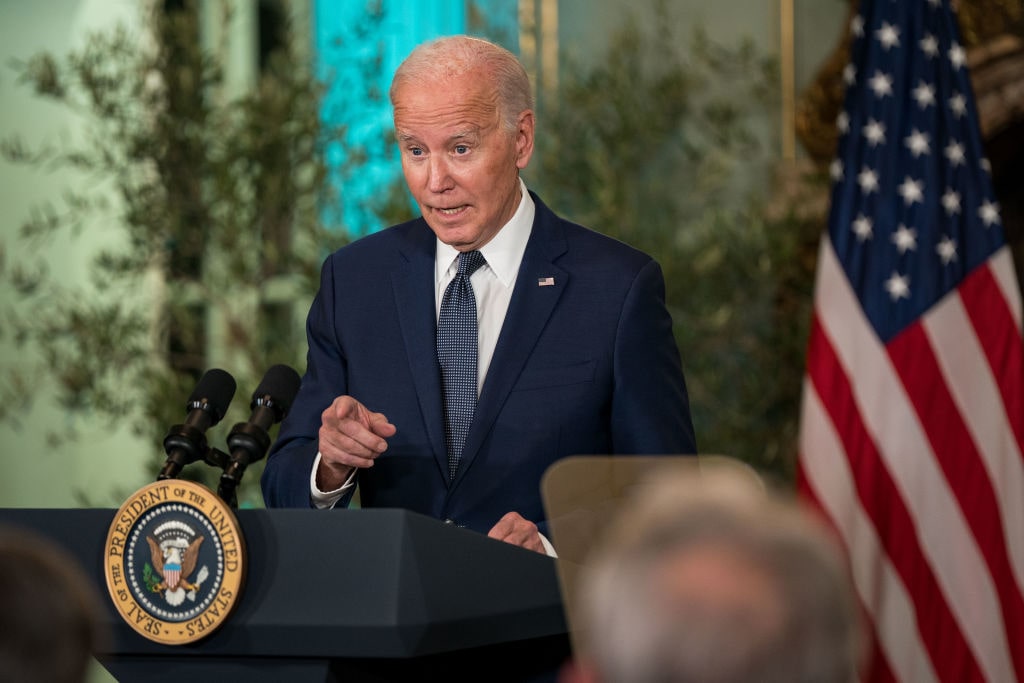Billions in corporate welfare turns to dust.
President Joe Biden will be in Colorado today, November 28, to champion green energy policies inside his Inflation Reduction Act and the CHIPS and Science Act. He will spend time in Denver and Pueblo to tout a couple of wind-related factories that are set to take advantage of the administration’s corporate welfare scheme. The president, facing abysmal polling data one year away from the election, will target Republicans and point out how they voted against his investments and job creation efforts. Clean energy, like wind, has been the focal point of Bidenomics. But have the billions in federal and state funds poured into the private sector yielded tangible results?
Green Energy Setbacks
 By 2030, the Biden administration aims to generate 30 gigawatts of offshore wind power. This would be enough to power ten million US households. Is this doable? The road to green energy has hit a couple of roadblocks in recent months, leaving some industry analysts to warn that the goal is unlikely to be reached in seven years.
By 2030, the Biden administration aims to generate 30 gigawatts of offshore wind power. This would be enough to power ten million US households. Is this doable? The road to green energy has hit a couple of roadblocks in recent months, leaving some industry analysts to warn that the goal is unlikely to be reached in seven years.
Earlier this month, Orsted, an international energy developer, put the kibosh on two major offshore wind projects off New Jersey’s coast. The Denmark-based company confirmed that the board of directors voted to cancel the high-profile Ocean Wind 1 and Ocean Wind 2 amid high inflation, supply chain snafus, and increasing interest rates. In July, the White House celebrated these green energy projects, which were projected to offer more than 2.2 gigawatts of power, for being examples of “Bidenomics in action.”
The Danish firm’s cancellations came around the same time other developers in the New England region announced that they were ending power contracts for three projects. These were supposed to generate 3.2 gigawatts of wind power for Connecticut and Massachusetts.

(Photo by Kent Nishimura/Getty Images)
These developments accounted for close to one-fifth of the White House’s 2030 objective. But these were not all, as several other organizations, including BP and Shell, canceled or sought to renegotiate power agreements for wind farms that were set to be operational sometime between 2025 and 2028. In July, Rhode Island Energy chose not to move forward with several offshore wind turbines due to soaring costs that would have put tremendous pressure on customers’ wallets.
Michael Brown, the US country manager for Ocean Winds, an offshore wind joint venture between France’s ENGIE and Portugal’s EDP Renovaveis, told a Reuters Events conference this past summer: “Thirty gigawatts is now unfortunately not something that the developers are really aspiring to. We want to meet as high a gigawatt target as possible, but it’s not going to be possible to meet those 30 GW.” Timothy Fox, a ClearView vice president, concurs. However, he believes the US will eventually reach the 30-gigawatt target and surpass the mark.
Like the “net zero by 2050” dream, this is yet another climate-related vision that will not be realized.
Nevertheless, the Biden administration is not conceding defeat. In September, White House spokesperson Michael Kikukawa confirmed that Biden will be “using every legally available tool to advance American offshore wind opportunities and achieve the goal of 30 GW by 2030.” One of these tactics is increasing handouts to domestic and foreign firms. Over the last year, the federal government has bolstered wind investments by $7.7 billion, mainly in the form of tax credits for green energy. The sector says this is not enough, and reports suggest that a plethora of US offshore wind project developers are lobbying Washington for more subsidies. Companies are struggling to bring these endeavors online, even with generous assistance from all three levels of government, because of the current inflationary and high-rate environment.
This does not mean the green energy movement is over. In fact, a chorus of Democrats, including Sen. Brian Schatz (D-HI), says that the recent blows to the green energy crusade are mere “bumps in the road” and that the president’s legislative trifecta is exceeding all expectations “and we just need to do more of it.” Republican lawmakers disagree, warning that the incumbent regime is wasting taxpayer dollars on something private companies cannot make work without additional funding.
Blowing in the Wind
President Biden will use his two pitstops in The Centennial State to push Bidenomics, promoting the accomplishments and masking the many failures. As Liberty Nation reported, administration officials have found a new scapegoat for why the president’s economic agenda is unpopular with the American people: allies in the mainstream media. So, Colorado voters will be presented with the same Biden entertainment: a two-second half-jog, a story about the folks in Scranton, mispronounced names of local representatives, and repeating the doctrine of growing the economy from the middle out and the bottom up. Unfortunately, those in attendance will not be informed that critical planks of the president’s schemes have stumbled, much like a particular US president.

